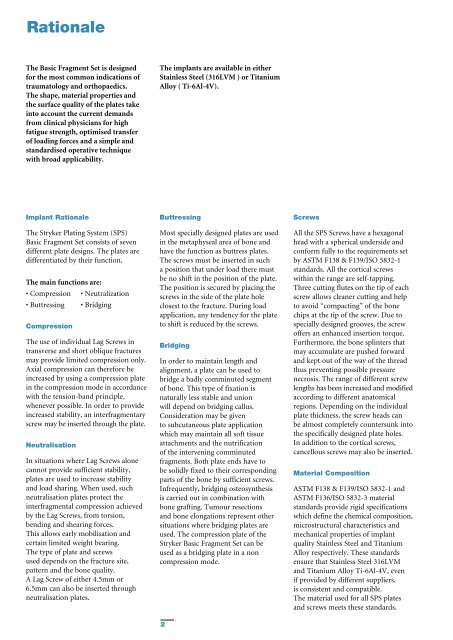SPS Basic Fragment Set - Stryker
SPS Basic Fragment Set - Stryker
SPS Basic Fragment Set - Stryker
You also want an ePaper? Increase the reach of your titles
YUMPU automatically turns print PDFs into web optimized ePapers that Google loves.
Rationale<br />
The <strong>Basic</strong> <strong>Fragment</strong> <strong>Set</strong> is designed<br />
for the most common indications of<br />
traumatology and orthopaedics.<br />
The shape, material properties and<br />
the surface quality of the plates take<br />
into account the current demands<br />
from clinical physicians for high<br />
fatigue strength, optimised transfer<br />
of loading forces and a simple and<br />
standardised operative technique<br />
with broad applicability.<br />
The implants are available in either<br />
Stainless Steel (316LVM ) or Titanium<br />
Alloy ( Ti-6Al-4V).<br />
Implant Rationale<br />
The <strong>Stryker</strong> Plating System (<strong>SPS</strong>)<br />
<strong>Basic</strong> <strong>Fragment</strong> <strong>Set</strong> consists of seven<br />
different plate designs. The plates are<br />
differentiated by their function.<br />
The main functions are:<br />
• Compression • Neutralization<br />
• Buttressing • Bridging<br />
Compression<br />
The use of individual Lag Screws in<br />
transverse and short oblique fractures<br />
may provide limited compression only.<br />
Axial compression can therefore be<br />
increased by using a compression plate<br />
in the compression mode in accordance<br />
with the tension-band principle,<br />
whenever possible. In order to provide<br />
increased stability, an interfragmentary<br />
screw may be inserted through the plate.<br />
Neutralisation<br />
In situations where Lag Screws alone<br />
cannot provide sufficient stability,<br />
plates are used to increase stability<br />
and load sharing. When used, such<br />
neutralisation plates protect the<br />
interfragmental compression achieved<br />
by the Lag Screws, from torsion,<br />
bending and shearing forces.<br />
This allows early mobilisation and<br />
certain limited weight bearing.<br />
The type of plate and screws<br />
used depends on the fracture site,<br />
pattern and the bone quality.<br />
A Lag Screw of either 4.5mm or<br />
6.5mm can also be inserted through<br />
neutralisation plates.<br />
Buttressing<br />
Most specially designed plates are used<br />
in the metaphyseal area of bone and<br />
have the function as buttress plates.<br />
The screws must be inserted in such<br />
a position that under load there must<br />
be no shift in the position of the plate.<br />
The position is secured by placing the<br />
screws in the side of the plate hole<br />
closest to the fracture. During load<br />
application, any tendency for the plate<br />
to shift is reduced by the screws.<br />
Bridging<br />
In order to maintain length and<br />
alignment, a plate can be used to<br />
bridge a badly comminuted segment<br />
of bone. This type of fixation is<br />
naturally less stable and union<br />
will depend on bridging callus.<br />
Consideration may be given<br />
to subcutaneous plate application<br />
which may maintain all soft tissue<br />
attachments and the nutrification<br />
of the intervening comminuted<br />
fragments. Both plate ends have to<br />
be solidly fixed to their corresponding<br />
parts of the bone by sufficient screws.<br />
Infrequently, bridging osteosynthesis<br />
is carried out in combination with<br />
bone grafting. Tumour resections<br />
and bone elongations represent other<br />
situations where bridging plates are<br />
used. The compression plate of the<br />
<strong>Stryker</strong> <strong>Basic</strong> <strong>Fragment</strong> <strong>Set</strong> can be<br />
used as a bridging plate in a non<br />
compression mode.<br />
2<br />
Screws<br />
All the <strong>SPS</strong> Screws have a hexagonal<br />
head with a spherical underside and<br />
conform fully to the requirements set<br />
by ASTM F138 & F139/ISO 5832-1<br />
standards. All the cortical screws<br />
within the range are self-tapping.<br />
Three cutting flutes on the tip of each<br />
screw allows cleaner cutting and help<br />
to avoid “compacting” of the bone<br />
chips at the tip of the screw. Due to<br />
specially designed grooves, the screw<br />
offers an enhanced insertion torque.<br />
Furthermore, the bone splinters that<br />
may accumulate are pushed forward<br />
and kept out of the way of the thread<br />
thus preventing possible pressure<br />
necrosis. The range of different screw<br />
lengths has been increased and modified<br />
according to different anatomical<br />
regions. Depending on the individual<br />
plate thickness, the screw heads can<br />
be almost completely countersunk into<br />
the specifically designed plate holes.<br />
In addition to the cortical screws,<br />
cancellous screws may also be inserted.<br />
Material Composition<br />
ASTM F138 & F139/ISO 5832-1 and<br />
ASTM F136/ISO 5832-3 material<br />
standards provide rigid specifications<br />
which define the chemical composition,<br />
microstructural characteristics and<br />
mechanical properties of implant<br />
quality Stainless Steel and Titanium<br />
Alloy respectively. These standards<br />
ensure that Stainless Steel 316LVM<br />
and Titanium Alloy Ti-6Al-4V, even<br />
if provided by different suppliers,<br />
is consistent and compatible.<br />
The material used for all <strong>SPS</strong> plates<br />
and screws meets these standards.

















